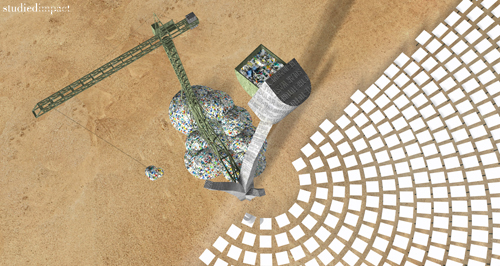
(Studied Impact Design) click to see larger image
We designed the Plastikoleum Tower after being impressed with the idea that the Japanese inventor Akinori Ito came up with to convert plastic waste back into the raw petroleum from whence it originally came. His company, Blest Corporation, sells various scales of his converter from 1kg capacity to 50kg. Ito has been traveling around the world demonstrating the small desktop version (shown below) which can convert 1 kg of plastic waste material into 1 liter of oil which can be refined into gasoline, kerosene, or diesel.
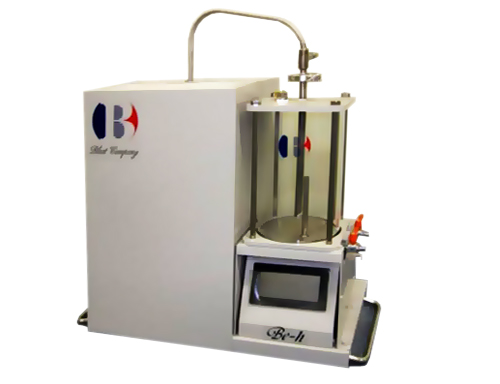
What got us thinking is that the hour long process requires about 1KWh of electricity to create each liter of oil (the plastic must be heated to 500 degrees Celsius). Since one liter of oil equivalent equals 11 KWh (measured in BTU’s), the process itself uses up 9% of the energy that is contained in the resulting product. We thought: what if instead of the electricity for the conversion coming from the grid (fossil fuel generated electricity), it came directly from the sun? And what if instead of converting 1-50 kg of plastic, it converted 10 tons of plastic each hour?
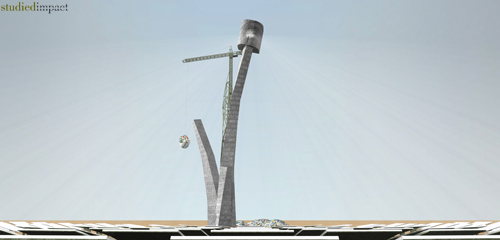
(Studied Impact Design) click to see larger image
We designed the Plastikoleum Tower as an interesting variation on the conventional solar power tower. The latest generation of this particular concentrated solar power technology is getting very efficient and is able to maintain 15 hour cycles of heat that maintain at least 500 degrees Celsius. For more about these, see the Torresol Energy Gemesolar plant (a collaboration with Masdar).
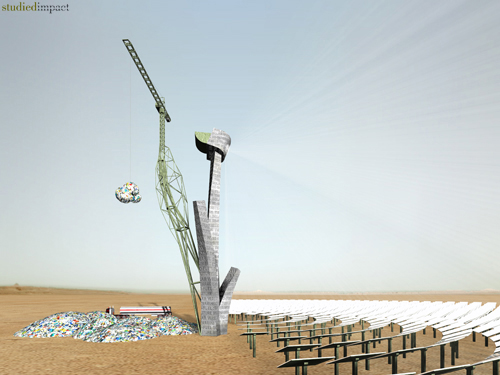
(Studied Impact Design) click to see larger image
The Plastikoleum Tower is basically the same thing, except that instead of using the heat to create steam for turbine electricity generation, it is used to create oil from plastic waste. At this level of production, we could put a nice dent in the millions of tons of plastic waste that is discarded every year and would otherwise end up completely unused in landfills. So the raw material is basically free. The oil product can be sold at $100 per barrel (as of this post) and has the added benefit of cleaning up the environment of plastic waste.
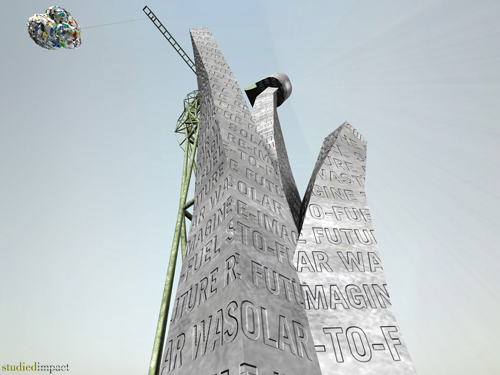
(Studied Impact Design) click to see larger image
Solar power towers generally are sized at around 20MW capacity. We’ve sized ours only at the capacity (10MW) that would be required to heat 10 tons of plastic (scaling up from the smaller models designed by Akinori Ito). At 10 tons per hour capacity, the tower could produce 60 barrels of oil every hour, or 900 barrels per day. With economies of scale in effect, it may be that 10MW could actually produce much more than that, but we’re being conservative in our estimate.
900 barrels per day would therefore net $90,000 per day from plastic feedstock that is either free or that the company could even charge for to help dispose of. That comes to $32 million per year in revenues, which should pay back the capital costs of the construction within just two years (based on a construction estimate of $2.5 million per MW installed capacity and accounting for operational expenses).
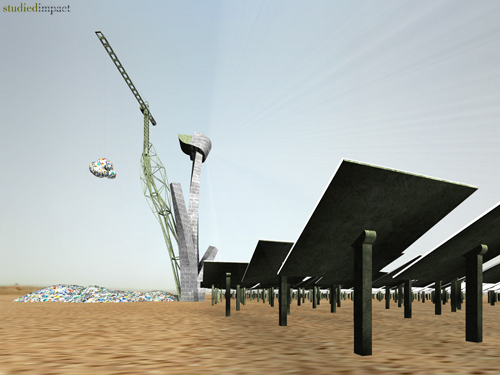
(Studied Impact Design) click to see larger image
It should be noted that burning the resulting oil fuel will still contribute to CO2 emissions. But leaving the plastic in landfills also contributes to perhaps greater greenhouse gas emissions, and burning the plastic as-is creates 5x the CO2 emissions as compared to burning the oil that the plastic melts down into.
The amount of oil per tower (900 barrels) that would be produced is literally a drop in the bucket (Abu Dhabi produces 2.8 million barrels per day). Nevertheless, towers such as this could become a useful source of fuel energy for geographical locations that have a lot of sun and a lot of plastic waste.
We can see these being built in tandem with electricity generating towers in the future. Or perhaps residual heat energy within the Plastikoleum Tower can be used to generate steam power at the same time as the plastic is melted within the same tower (by running water through pipes within the melting chambers).
Another thought is integrating this system into the fabric of a new urban community. The plastic is not combusted in the process (the heating must occur in a chamber free of oxygen) so there is no off-gassing or fumes of any kind. We can imagine an Ebenezer Howard garden city plan (one of his radial utopias), with each house shaded by a large heliostat.
Here’s a short video about Ito’s invention:
We learned about Blest Corporation via Inhabitat, Plastics Today, and Clean Technica
Related Posts
8 Comments
Add comment Cancel reply
This site uses Akismet to reduce spam. Learn how your comment data is processed.

if you can send me some information, in where i can buy this machines for use in mexico city? please
WERE DO YOU HAVE FOR SALE THIS MACHINES?I WANT TO BRING YOUR INVENTION TO MEXICO CITY.
WOULD YOU PLEASE CONTACT ME?THANK YOU¡¡
[…] podemos ver una futurista torre tecnológica que según cuentan es capaz de producir petróleo a partir de desechos plásticos , es decir , […]
[…] Original:Be-h | Plastikoleum Tower blog comments powered by Disqus […]
[…] 10/30/10 */ google_ad_slot = "3364119883"; google_ad_width = 468; google_ad_height = 15; Wow. The Land Art Generator Initiative took inventor Akinori Iti’s idea to convert plastic back to petroleum and figured out how to […]
Interesting concept and good work of Akinori Ito. I’m interested if such a project got realised yet?
[…] El nombre con el que ha bautizado a su invento es Plastikoleum y parece doblemente útil, no solo porque es una forma rápida y barata de conseguir petróleo, sino porque además se recicla gran parte del plástico que acaba en la basura de forma muy práctica y eficiente. Más información: link […]
[…] the people behind the Land Art Generator Initiative heard about inventor Akinori Ito’s machine, which converts plastics back into oil, they came up […]